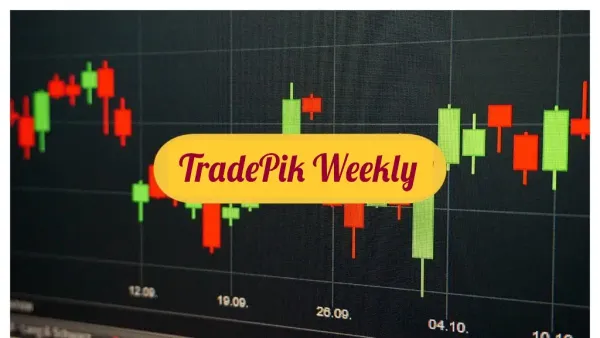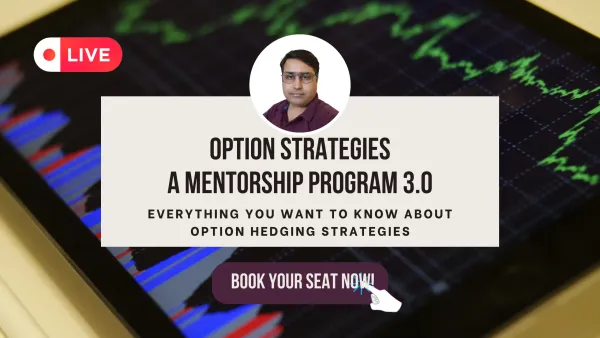How to Trade Options? 2 best options strategies for beginners

Options trading always fascinate to the traders in share market, especially to those who have just started their trading career. But if you don’t know how to trade options, this can leads to a huge loss.
Before we jump into How to trade options? There are some terms you need to understand before you start options trading. In this article, I’m sharing these standard terms and two simple methods you can follow to trade options.
Introduction to options trading
An option is a financial contract in which the buyer is artificially taking a buy/sell position in a stock or currency or commodity etc. and a seller takes the opposite side position of buyer i.e. an artificial sell/buy position respectively in the asset classes mentioned. Here, we will only consider stocks. Since position in an option is based upon a stock, the stock here is called as underlying asset.
Types of Options
Now, there are two types of Options –
(1) Call Option
(2) Put Option
(1) Call Option
A call option is that one in which its buyer/holder expects the underlying asset to rise in the future and its seller/writer expects the stock/indices related to fall in the future.
Let’s say A expects Reliance stock to rise above 1650 in the near future. So, that person will buy a call option at a price of let’s say 1575. It’s to be remembered that he can buy the option at other prices also.
These prices are known as strike prices. Similarly, we have the case of option seller B who sells the option at the strike of 1575 with the expectation of stock falling below; let’s say the current price of Reliance of INR 1575 to below 1500 in the near future.
(2) Put Option
A Put option is one in which the buyer expects the underlying stock/indices to fall in the near future and its seller on the other hand expects it to rise. Let’s say X expects Marico stock to fall below 300 in the future. Thereby, he can buy Put at the strike of INR 330.
Let’s assume that the current market price of Marico is 335. This market price is called the spot price. So, now we go on to the seller’s view. Seller Y expects Marico to rise above 370 in the future. Thereby they both enter into a Put contract based upon their respective expectations.
The famous options traded are of Bank Nifty and Nifty 50 Indices respectively.
- Check this also: Best Bank Nifty Option Buying Strategy for Intraday
Some common terms used in Options trading
So, now being clear with what Call and Put Options are respectively, we get into the common feature of both of them “Premium”. Options are traded at a price called Premium. These premiums are available for different strikes.
Now, all of these options are valid till a specific date which is every Thursday of a week or last Thursday of a month. The respective Thursdays are called exercising/expiry dates of an Option. If the option contract is exercised on one of these days, the price at which they are settled is called the exercised price i.e. the spot price.
Now, let’s see some common terms applicable to both the Calls and Puts.
What is Volume?
Volume for a specific point of time describes the total worth of an option contract traded. The total worth or combined strength is on either the “Buy” or “Sell” side. Volume can be seen ranging from 1 Minute to 1 Month on a chart.
What is Open Interest?
Open Interest refers to the contracts which are open at a time i.e. they haven’t been completed i.e. sold or bought after they have been bought or sold respectively at the available strike prices.
We have to keep in mind that top 3-4 stikes with the highest Open Interests’ should be analyzed first then other remaining strikes. It will form a general view of the entire Option Chain and indicate whether the market sentiment is bearish (downwards), bullish (upwards), or Sideways (Range-bound).
We have created a small course where we have shared how you can read open interest data to find intraday trends and decide your trades. Click on below button:
Change in Open Interest
This simply shows the Change in Open Interest at different points of time in the market. It’s calculated with respect to the previous trading day for a particular day.
This needs to be monitored as whenever the noticeable positions are added or closed in a particular Options contract, a hint about the market’s expected movement in the future can be derived.
It’s to be kept in mind that the Futures and Spot/Cash market should also be analyzed to know the overall trend formation for the market in the future.
Last Trading Price (LTP)
LTP (Last trading price), As the name suggests, it shows the price at which the option is just traded i.e the last trading price of at that particular strike or options.
Net change
This shows the change in premium for an option contract on a particular trading day at different points of time with respect to the previous day’s price i.e. closing price.
What is Strike Price?
As mentioned with respect to our examples of Reliance and Marico, strike price is the respective price with respect to an Option Contract.
For example, if you are buying a Call option in Nifty of 10,000 (not the current market price), then 10,000 is called the Strike Price. If the market is let’s say trading at 10,050 currently then 10,050 will be your Spot/Cash price and 10,000 here will be your Strike Price.
What is Implied Volatility (IV)?
Implied Volatility indicates the expected movement of the underlying asset in the future i.e. for a year. It can be computed for a month/week/day with the below formula:

The movement it’s to be remembered can happen on either of the direction i.e. the underlying can fall or rise by that particular percentage of Implied Volatility.
The movement of the underlying can happen on the Upside when there is an increase in IV of Call and a decrease in IV of Puts. Similarly, it can happen on the downside when there is an increase in IV of Puts and a decrease in IV of Calls. There are different IVs for different strikes. These IV’s also keep on changing from time to time.
What is Lot Size?
It’s to be noted that an option is traded in Lots. A Lot has a prescribed quantity of the underlying asset whether an Index/Stock. This prescribed quantity keeps on changing from time to time as per the Exchange’s guidelines and is known as Lot Size. For example, the current 1 Lot of Nifty has 75 quantities i.e. Lot Size is 75 in the case of Nifty 50 index. Same as BankNifty it’s 20.
What is Option Chain?
Let’s have a look at the Option Chain of TCS as on 3/6/20.

The above screen shows the Call and Put Options activity of TCS for expiry date of 25/6/20 with all the headers common to options. Hence, thereby it’s called the Option Chain.
Now, let’s talk about Options based on a trader’s position taking (not according to his profit/loss position). Given is the Nifty 50’s Option Chain as on 3/6/20-

(1) In the Money Option (ITM)
Nifty’s spot price is 10,061.55 currently. If you bought call at 10,000 strike, then you are “in the money”. This is because you bought at a cheaper price i.e. 10,000 and the spot is currently above 10,050 enabling a rise in the call option’s price. Similarly, a Put buyer is “in the money” only when his strike price is greater than the spot price for example a 10,200 put buyer currently.
So, when an Option is both “In the Money” and “Profitable”, the respective profitable value is called the Intrinsic Value of an Option Chain. Here, Intrinsic Value will be (Strike price – Spot) for a Put contract and (Spot price – Strike price) for a Call contract.
(2) At the Money Options (ATM)
Let’s suppose that you have a put/call buy position at strike price equal to current market price of a stock. This simply means that you are in “at the money” contract currently. For instance, you can say that 10,050 strike Call and Put Buyers are “at the money” currently. An “at the money Option” has zero Intrinsic Value.
(3) Out of the Money Options (OTM)
An option is “out of the money” if strike price is greater than spot price in case of Call buying like @ 10,500 call option. A put buyer will be “out of the money” if his strike price is less than the current spot price of the underlying. For example like 9,800 Put buyer is at the moment.
Amazing, we have now learned the basics of Options which serves as a starting step to address the part for which we are here for: “How to Trade Options”?
- Check this also: Best Option Selling Strategy for Intraday in Nifty and BankNifty
What are Option Greeks?
Option Greeks, well it’s not as tricky as it sounds. There are different types of Option Greeks/Analysis tools as follows –
(1) Delta
It means a change in the option’s premium, which is expected to happen with a percentage change in the underlying stock’s/index price. Calls have a delta from 0 to 1 since they have a positive relationship with the underlying price. That is, call premiums to rise when the index rises and fall when the index falls. Puts have a negative delta from 0 to -1 due to their negative price relationship with their respective underlying. That is, Put premiums rise when the Index falls and fall when the Index rises.
(2) Gamma
It refers to the rate of change in Delta. It’s 0 to 1 for Calls and 0 to -1 for Puts. At the money, calls have greater Gamma potential. This means that option’s price can make a significant movement from the current spot/strike towards 1 in case of calls with a significant upward spot move and -1 in Puts with a significant downward spot move. In-the-money Calls/Puts, have their delta changing pace less than at-the-money Calls/Puts. Out-of-the-money calls/, puts have little possibility of a good change in Delta unless there is a sharp up move/down move at stock/index price due to any news/event.
(3) Rho
It refers to the extent of change that can happen in an option’s premium due to a percentage change in risk-free interest rates. The interest rates are related to the Govt. of India Treasury Bills. Rho has a positive effect on Call premiums and a negative one on Put Premiums.
(4) Vega
It refers to the change resulting from Implied Volatility (IV) on an option’s price. If IV increases, an option’s price increases, and when IV decreases, an option’s price decreases.
(5) Theta
It refers to the reduction in an option’s value, which happens as it nears its expiry date. Theta has a negative value for both Call and Put since it leads to a reduction in each of the option’s value.
So, now having learned about Greeks, you might be wondering how to Trade Options using them. Well, no more waiting here we see-
- Wanted to learn options from basics to advanced? Check out our Option Strategies: A Mentorship Program
How to trade options with the Greeks?
This simply means we have to look at the underlying’s chart and Greeks values. For example, take the chart of TCS-

The highlighted area is from 19/3/20 to 3/6/20 i.e. the current date. Note that the stock is in an uptrend making higher highs and higher lows respectively.
Buying calls is ideal in this kind of scenario with their premiums rising. This is a directional up move that directly affects Delta as lower highs and lows are made. Thereby, the Gamma also shoots.
Also, one should note IV and plot its Chart/see it if available with a broker. If the IV takes support and starts to rise, it adds to an Option’s value. Thereby, in this case, Call Premiums will rise due to the combined effect of Delta, Gamma, and Vega. Theta effect on an option’s premium is cancelled out by Delta, Gamma, and Vega’s combined effect.
Now, let’s look at the downtrend case.

TCS downtrend area from 11/3/20 to 19/3/20 is highlighted. Also, due to COVID-19 situation stock was volatile. So, at this time IV on the relevant Put strikes with respect to this area would be on the higher side. The directional downward trend of the stock causes an increase in Delta and Gamma also on the Puts. Thus, buying Puts would be a good idea in this case. Hence, in this case, also Theta effect would be cancelled out by Delta, Gamma, and Vega.
Now, let’s look at Put/Call selling case-

In the indicated area the TCS stock is in a range from 1930 to 2265 about levels. So, when the stock reaches the upper range Call writing would have been a good idea.
Being not in an uptrend and facing resistance around the upper range, there would not be a continuous increase in Delta and Gamma. The IV Chart facing resistance at the top lowers down the premiums of options.
Thereby, Theta, which decreases the option’s value when it approaches expiry, would overpower Delta and Gamma effects. The decreasing IV, a good Theta, and an upper range resistance made Call writings (selling at a higher premium level and buying at a lower premium later) a good cause.
Similarly, when TCS came near about 1930 odd levels Put writings made a good case.
Also, it’s to be noted that the stock was making ranges in between also, thereby presenting considerable opportunities for making profits for the option sellers.
Remember that Theta has a maximum effect when a week is remaining to option expiry.
Note – Buy/sell the options near the crucial Support/Resistance areas after being confirmed by your analysis of Support and Resistance.
So, by now you have got a fair idea of how to trade options using Option Greeks.
India VIX and its Relation to Options Premiums
India VIX (Volatility Index) is a measure of Volatility, i.e., rapid up and down movements in the stock market. Usually, it’s seen that when India VIX is below 16, markets go higher and are stable in their price movements.
A Higher VIX reading indicates uncertainty in the market; for example, when the lockdown was imposed, the market didn’t know when the restrictions would be lifted. But as we moved forward towards gradually relaxing the Economic restrictions, India VIX went lower as shown below –

India VIX as on 2:28 P.M., 4/6/20
So, when the markets go higher in a clear cut trend Call premiums rise, and thereby it is advisable to buy calls. However, if India VIX rises to unusual levels as seen above, generally the market falls.
That fall comes up with huge velocity. In this situation, the premiums of Puts rise, thus presenting a good opportunity for Put buyers. However, it’s to be noted that the market is making a downtrend at a rapid pace, and also, there can be rapid bounces of rising in between.
Therefore, beginner traders should stay away from such markets unless they know the market’s ins and outs and are risk-seeking.
Now, let’s discuss a strategy highlighting “how to trade Options using India VIX”.
How to Trade Options Using India VIX?
India VIX indicates volatility per annum considering the current market conditions. Let’s understand and know the concept-
Let’s suppose that the spot price of Nifty at the day’s end is 8879. Assume that India VIX is 39.1% at this point. This means that the Nifty can move 39.1% up/down from 8879 respectively. Note that this India VIX no. is for the next 30 days showing an estimated 1-year reading.
To arrive at a daily/expiry day strategy, we have to convert this Annual % of VIX into Monthly, Weekly, and then Daily %, the formula for that is-
- Daily Movement = VIX/Square root of (No. of days)
Accordingly, we will have 2.05% as Daily VIX.
So, for taking trade on the next trading day we will plus/minus 2.05% from 8879 to arrive at higher/lower points of Option Selling.
We have to sell only Out of the Money Options. This means that we have to write either Put concerning the higher point of 9,061 or Call at the lower point of 8697. You can add/subtract plus 100 points more to the higher/lower points for your better risk management and then write an option at one of those points.
The question is whether to write a Call or Put factor in Theta for this purpose. For the option which has a greater relative Theta value on the negative side, Write that option.
For example, let’s say Theta is minus 4 at 9,100 Put (Nifty Options are at a gap of 50 each) and -2 at 8,650 PUT respectively. The Last Trading Price (LTP) of 9100 Put is let’s say 10 INR and of 8650 PUT is 7 INR. Relatively, Theta would be –
- -2/7= -28.57% (8650 PUT)
- & -4/10= -40% (9100 PUT)
Hence, we will choose the 9100 Put Option for selling as it has a higher relative Theta value on the negative side. Writing Options only 2-3 days before the expiry is best if you are less risk-seeking as the Theta factor plays in the best on these days. Volatility is expected to be low on 2-3 days before expiry.
Thereby, the market shouldn’t be volatile for having successful option writing. It’s recommended not to carry forward your position the next day if you are doing option selling daily and close your sell position on that day itself.
How to Trade Options using Far off and Near Strikes?
Let’s say Nifty Spot is 8,540 currently. So, nearby strike prices will be 8,550 and 8,500, respectively. Accordingly, the far-off strikes would be 8,250 and 8,200, respectively, i.e., strikes away from the current Spot. A 300 points difference would be good for a clear cut directional Option trade.
Now, assume that there is heavy, i.e., reasonable Open Interest (Top 4 Open Interests in descending order) built up around the near and far strikes mentioned. There is also Put buying and closing/selling the Call Buy Positions at these near and far strikes.
So, therefore we have a clear-cut downward view of Nifty. One can buy Puts at the nearby strikes of 8,550 and 8,500 to enjoy their premiums rise. All of this can be confirmed by looking at the Price and Volume of the Nifty Spot and the Options’ Strikes mentioned. Both price and volume should indicate a downward trend through the overpowering of the Buy positions by the Sell positions.
Some Important Points Related to Options Trading
- Take a Buy position in Options/Futures if you have selling ones in Options to protect your risk if you can. Conceptually, options’ selling is riskier as there is no limit on the premiums going to the upside but there is a limit to the premiums on the downside i.e. at max they can become zero. So always trade with proper hedging strategies like spreads.
- Set your stop loss on stock/indices as well as on the option you are trading.
- When you see the trend reversing, close your Option position, don’t wait.
- Remember that for little up/downside movements or for Rangebound markets Options selling is preferable. For markets going downwards/upwards in a clear trend Options buying is preferable.
- Track changes in IV and Open Interest. IV changes should be greater than 5% on a day-to-day basis. There should be a considerable change in Open Interest for building a view on what trade to take on in an Option.
- Don’t close your positions at the time of expiry. Close your options before expiry time as a beginner to avoid the complications and costs which come when you don’t square off/close your positions till expiry (let them automatically close at expiry).
- Trade with brokers that are less costly and have good Technology-based Infrastructure.
Conclusion: How to Trade Options?
I hope now you know ” How to trade options?” You can make some good money through options. Just remember to manage your risk and completely know about Options before taking trades in them. We have developed a very good Mentorship Program with a practical approach. If you want to learn more about options trading can enroll in this course.
Feel free to post your queries and feedback in the comment box related to options trading and tell me how you are trading options.
Disclaimer: Every strategy you are following has its limitations. No plan will work all the time. The strategies I have shared in the above post too have some limitations. So do proper research and follow a strategy for some time before entry into the live market.





